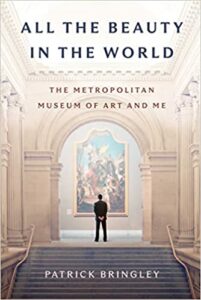Reviewed by Berta Winiker

Author Patrick Bringley recounts his ten years of work experience as a museum guard in this fascinating book. He had taken some art history courses in college and found them humbling. He was about to start work, however, in a glamorous midtown skyscraper at The New Yorker when life threw a huge curveball. He had just lost his older brother Tom to cancer and was grieving. He anticipated the meditative stillness of a necessary respite from the chaos of his churning thoughts.
He accepts the work opportunity to “come and interview.” Serious people are needed and he finds his way amidst folks with a wide range of skills and backgrounds. No cookie cutters here, but a diverse workforce. His coworkers may love art or may love the security aspect, maybe both. With time he finds himself idly chatting with them, adept at small talk, talking sports and inviting their stories. He marvels at having good friends twice his age from all corners of the world. A constant joke among his colleagues was “nothing to do and all day to do it.” They collegially offer each other a “personal” (bathroom break). With these coworkers exchanges naturally abound about patrons who approach with the staccato “bathroom” or “where’s the Mona Lisa.” The dark suits are paid to observe and Bringley does it well.
While reading the book, I thought of Studs Terkel’s Working: People Talk about What They Do All Day and How They Feel About What They Do. I wondered what key questions he might have asked Patrick. I considered my own experience with museum guards and can’t say that I felt encouraged to interact with them. Their stiff posture and watchful stance tells me to go about my business and only politely ask for directions to the bathroom. After reading the book, I have gained a deeper perspective and plan on some eye contact next time I have a museum opportunity.
Patrick would have been a lovely guard to meet. He reports that when a patron is entranced with an exhibit, they will approach and proclaim the beauty. He is also attuned to the eye-rolling reaction to something outlandish in the opinion of a patron. He goes with the flow reading the crowd, but will seize an opportunity to add value to someone’s visit. He enjoys children’s reactions to mummies, delights in playing teacher, and his people-watching comments are insightful and humorous.
I was most drawn to Patrick’s experience of navigating grief, becoming a family man, finding his people and deciding on his next career. I enjoyed walking in his shoes through the imposing Met and appreciated his hose allowance of $70 yearly. His coworkers also joke that the only thing that hurts about the job are their feet.
While my interest was keen in the memoir aspect of the book, there is plenty there for the art-loving reader. A substantive part of his days detail the settings where he is assigned and his descriptions of masks, medical instruments, and mummies. He does impart opinions and preferences for his varied perches and the reader does obtain a good sense of the day in the life of a museum guard. He talks about what goes on behind the scenes when the museum is closed—the preparation, restoration, renovation. It’s an impressive institution.
The book concludes with an extensive bibliography and also a list of artworks referenced in the text.
Return to Contents
